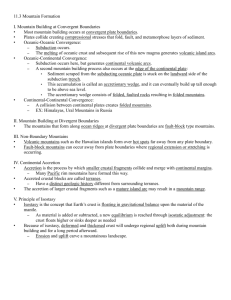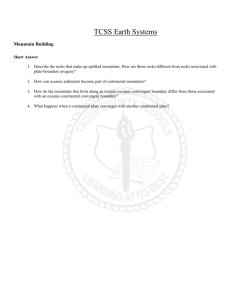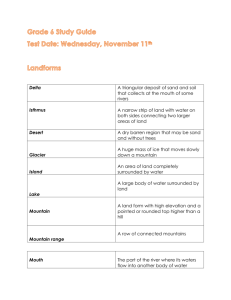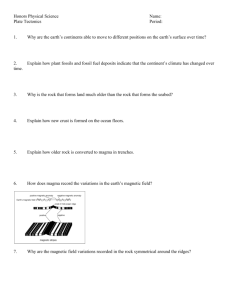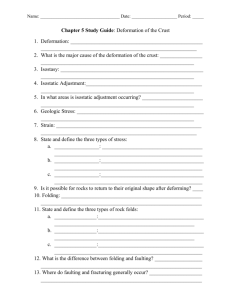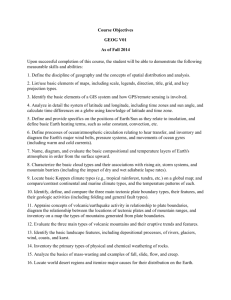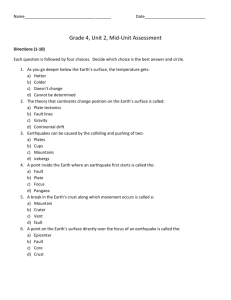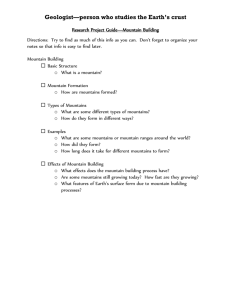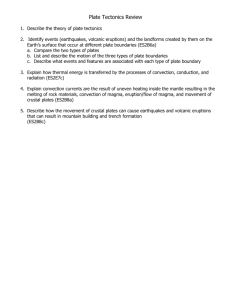Objectives: Chapter 8
advertisement
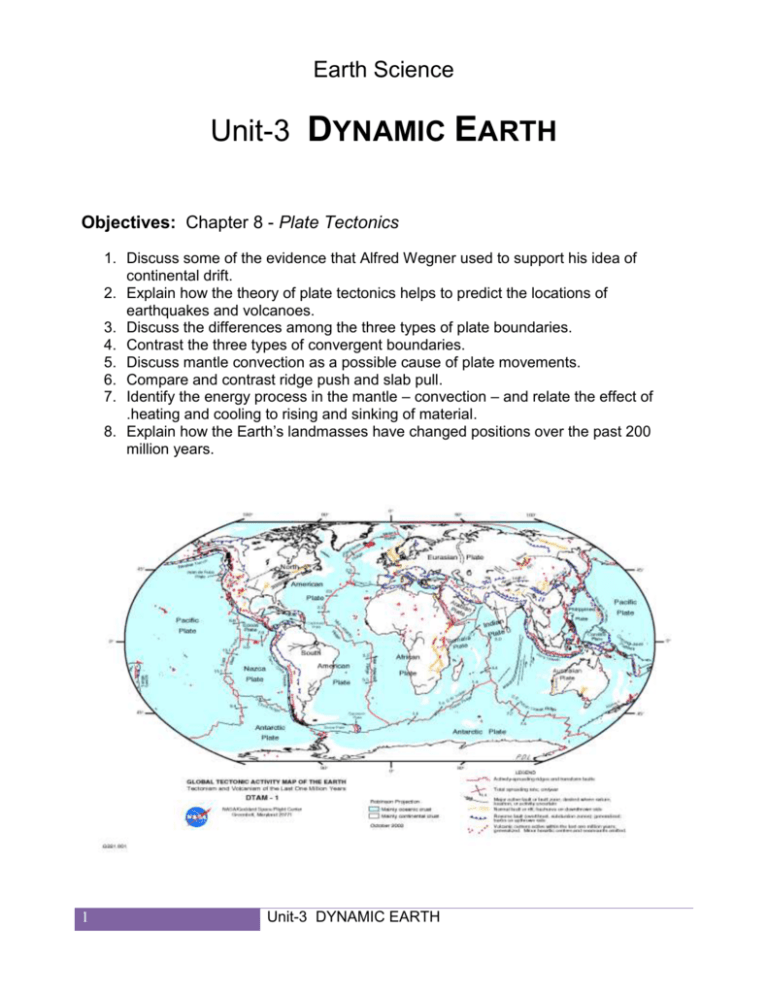
Earth Science Unit-3 DYNAMIC EARTH Objectives: Chapter 8 - Plate Tectonics 1. Discuss some of the evidence that Alfred Wegner used to support his idea of continental drift. 2. Explain how the theory of plate tectonics helps to predict the locations of earthquakes and volcanoes. 3. Discuss the differences among the three types of plate boundaries. 4. Contrast the three types of convergent boundaries. 5. Discuss mantle convection as a possible cause of plate movements. 6. Compare and contrast ridge push and slab pull. 7. Identify the energy process in the mantle – convection – and relate the effect of .heating and cooling to rising and sinking of material. 8. Explain how the Earth’s landmasses have changed positions over the past 200 million years. 1 Unit-3 DYNAMIC EARTH Chapter-8: Plate Tectonics To learn about Objectives-1&2, do the following: Read and outline Section 8.1: What is Plate Tectonics? Define Key Vocabulary: o Plate tectonics o Continental Drift o Mid-ocean ridge What observations support the continental drift hypothesis? How do observations of earthquake and volcanic activity support the theory of plate tectonics? What evidence in support of plate tectonics is provided by studies of the ocean floor? For Objectives 3 & 4, do the following: Read and outline Section 8.2 Define Key Vocabulary: o Divergent boundary o Rift valley o Rifts o Subduction boundary o Deep-sea trench o Collision boundary o Transform boundary Carefully copy the chart on page 179 onto your sheet. Explain how new oceanic crust is formed at a divergent boundary. Describe two different types of subduction boundaries, identify an example of each type (map on pages 712-713). Describe what happens at a collision boundary, identify a collision boundary (map on pages 712-713). Describe the movement of plates at a transform boundary, give examples. For Objectives 5, 6, & 7: do the following: Read and outline Section 8.3 “Causes of Plate Movement” With your group, work through Lab Activity “Convection Currents”. Copy the illustration at the bottom of page180. Define Vocabulary: o Mantle convection o Ridge push o Slab pull How does the mantle convection hypothesis explain plate movements at divergent boundaries and subduction boundaries? For Objective 8, do the following: Read and outline Section 8.4 “Plate Movements and Continental Growth” Describe what scientists hypothesize Earth’s surface liked like 200 million years ago and 180 million years ago. 2 Unit-3 DYNAMIC EARTH Define Vocabulary: o Pangaea o Craton o Terrane Describe at least two processes that contribute to the growth of continents over time. Chapter review questions on pages 190 – 191. Chapter 8 Test 3 Unit-3 DYNAMIC EARTH Chapter 9 – Volcanoes Objectives: Chapter 9 - Volcanoes 1) Analyze how magma forms as a result of plate motion and interaction. 2) Identify three types of magma and locate where each one forms. 3) Determine how the composition of magma effects the formation and structure of a volcano – shield, composite, and cone. 4) Classify volcanic activity on other planets and moons. 4 Unit-3 DYNAMIC EARTH Learning Activities 1) Objective: Analyze how magma forms as a result of plate motion and interaction. a. Read/Outline Chapter 9.1 “How and Where Volcanoes Form”, starting on page 194. b. Magma Formation: List the three (3) conditions that allow Magma to form. c. Briefly describe how Volcanoes form at the following three areas: i. Subduction Boundaries ii. Divergent Boundaries iii. Hot Spots 2) Objective: Identify three types of magma and locate where each one forms. a. Read/Outline Chapter 9.2 “Magma and Erupted Materials”, starting on page 199. b. Carefully copy the chart on page 199 “Characteristics of Magma” on to your notes. c. Briefly describe the two types of lava flows: i. Land ii. Water 3) Objective: Determine how the composition of magma effects the formation and structure of a volcano – shield, composite, and cone. a. Read and Outline Chapter 9.3 “Volcanic Landforms”, starting on page 202. b. Briefly describe how each of the following volcanic landform is formed and why: i. Shield Volcanoes ii. Cinder Cones iii. Composite Volcanoes iv. Calderas v. Lava Plateaus 5 4) Objective: Classify volcanic activity on other planets and moons. a. Read and Outline Chapter 9.4 “Extraterrestrial Vulcanism”, starting on page 206. b. Describe what type of volcanoes are found on the following planets: i. Mars ii. Venus iii. Io 5) Section review questions: a. 9.1: 1 thru 5 b. 9.2: 1 thru 5 c. 9.3: 1 thru 3 d. 9.4: 1 thru 6 Unit-3 DYNAMIC EARTH 6) Map Activity on page 208-209. a. Read and follow the “Procedures”. 7) Chapter-9 Review a. Vocabulary Review b. Concept Review c. Critical Thinking d. Interpreting Graphs Chapter-9 Test 6 Unit-3 DYNAMIC EARTH Mountain Building OBJECTIVES: Chapter – 11 Mountain Building 1) Explain how some of earth’s major mountain belts formed. 2) Compare and contrast active and passive continental margins. 3) Explain how compression, tension, and shear stress deform rocks. 4) Compare and contrast anticlines and synclines. 5) Distinguish among the three major types of faults – normal, reverse, and strike-slip. 6) Classify mountain ranges by their most prominent features. 7) Compare and contrast folded mountains, dome mountains, volcanic mountains, and fault-block mountains. 7 Unit-3 DYNAMIC EARTH Objective – 1: Explain how some of earth’s major mountain belts formed. Learning Activities – 1. Read section 11.1 “Where Mountains Form” 2. Define Key Vocabulary Key Vocabulary the following terms: a. Mountain b. Appalachian mountains 3. Writing: a. Explain how some of the mountain belts are formed. b. Where are most mountain ranges located? Objective – 2: Describe Compare and contrast active and passive continental margins: Learning Activities: 1. Define Key Vocabulary the following terms: a. Continental margin b. Passive continental margins 2. Writing: a. Compare and contrast Active and Passive continental margins: i. Locations ii. Similarities of material b. Look at the plate boundary map on pages 712-713. List at least two active continental margins and two passive continental margins. What mountain ranges appear to be associated with the active continental margins you identified? Objective -3: Explain how compression, tension and shear stress deform rocks. 1. Read the section “Types of Stress” in How Mountains Are Formed. (page 238) a. Define Key Vocabulary Key Vocabulary the following: i. Anticline ii. Syncline b. Write a description of each type of stress, and how each one works. i. Compression ii. Tension iii. Shear stress c. Draw a sketch of a compression, tension and shear stress. Use arrows to show forces acting on the rock. Objective-4: Compare and contrast anticlines and synclines Learning Activities: 1. Read section 11.2 “Folds” a. Write a comparison and contrast of anticlines and synclines. b. Draw a simple sketch of a syncline, and an anticline. 8 Unit-3 DYNAMIC EARTH Objective – 5: Distinguish among the three major types of faults – normal, reverse, and strike-slip. Learning Activities: 1. Read section 11.2 “Faults” a. Write a description of each type of fault. b. Draw a sketch of each type of fault c. Write an explanation of the difference between a normal fault and reverse fault. d. Describe the movement in a strike-slip fault. 2. Work with a partner and do the mini-lab on page 240 in your text book. Obtain the materials from your instructor. Write up the lab, and answer the “Analysis” questions. Objective – 6: Classify mountain ranges by their most prominent features Learning Activities: 1. Read section 11.3 “Types of Mountains” 2. Define Key Vocabulary the following terms: a. Folded mountain b. Dome mountain c. Fault-block mountain 3. What type of mountain tend to form when two landmasses collide? 4. Where do volcanic mountains tend to form? 5. How do fault-block mountains form? Objective – 7: Compare and contrast folded mountains, dome mountains, volcanic mountains, and fault-block mountains Learning Activities: 1. Fill in the following chart: Type of Crust Where are they found Uplift Mechanism Plutonic Dome Mountain: Tectonic Dome Mountain 9 Unit-3 DYNAMIC EARTH Examples of Folded Mountain Volcanic Mountain Fault-block Mountain Map Activity Purpose: To explore the locations and features of folded mountains. Skills and Objectives: Observe the locations of the major mountain ranges. Correlate mountain system locations with types of plate boundaries Compare and contrast continental and oceanic mountain ranges Infer the relative resistance to weathering of various rock types. With your lab partners, take out a clean sheet of paper. Label it “Chapter 11 Map Activity”. Carefully read the introduction on page 246 to this activity. Then work through this activity. Answer all the questions on the clean sheet of paper. You are now ready to take the test. Chapter 11 Test 10 Unit-3 DYNAMIC EARTH
